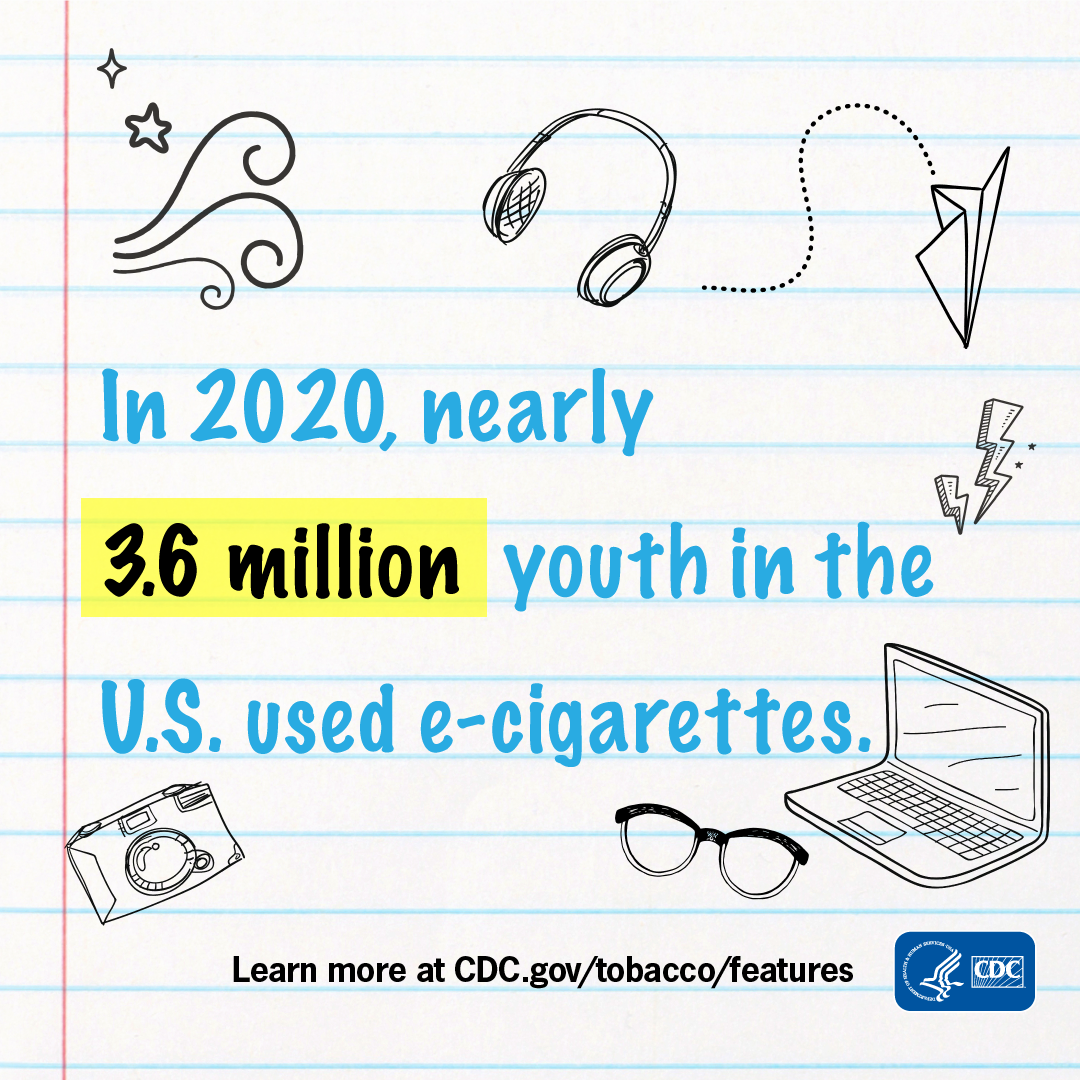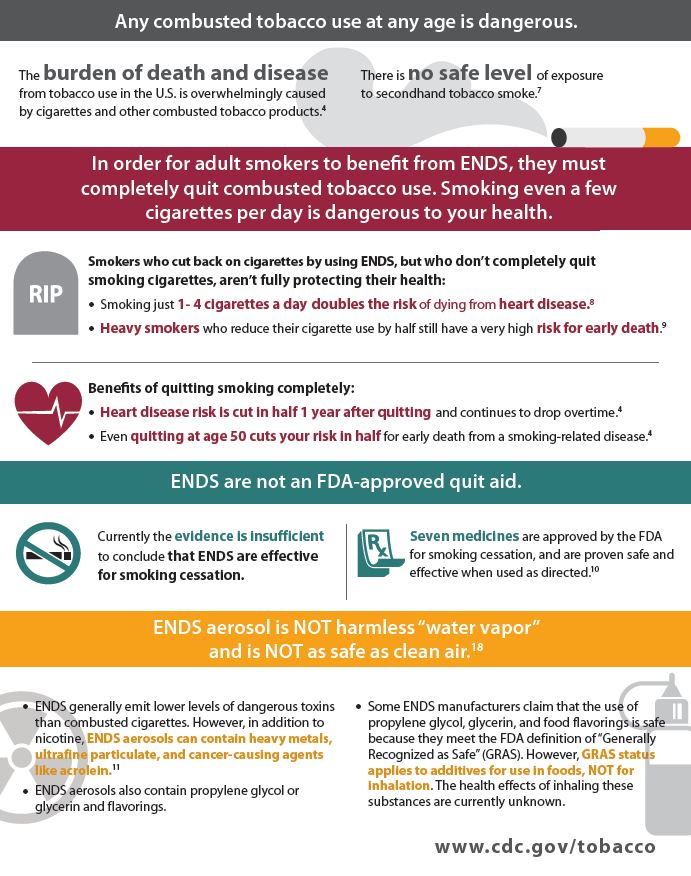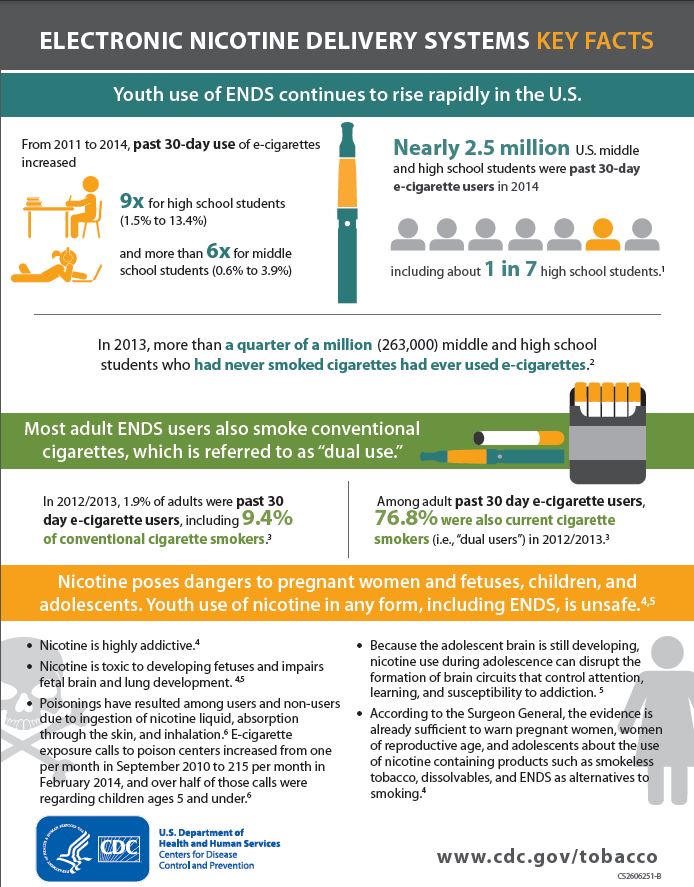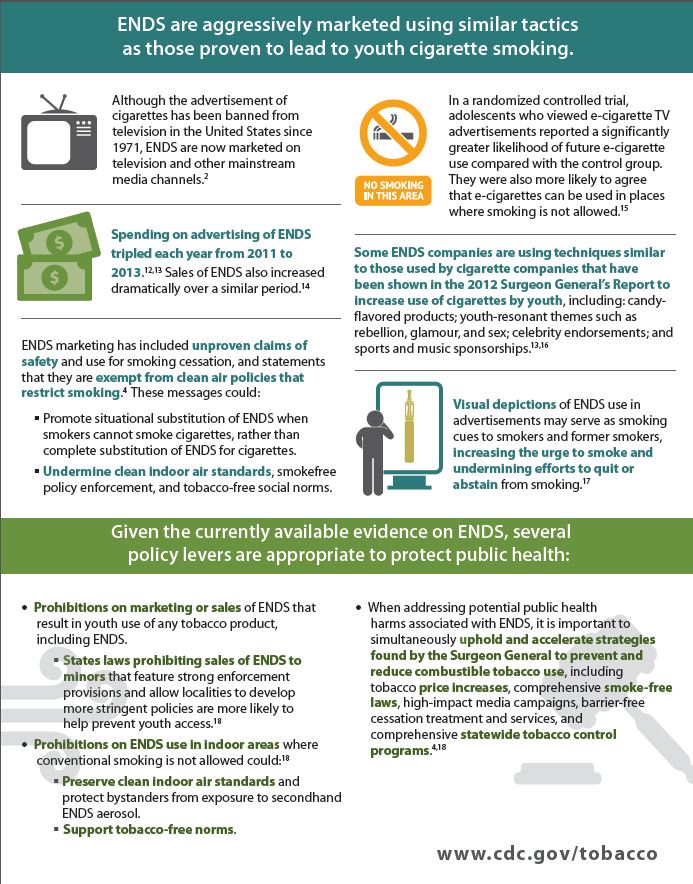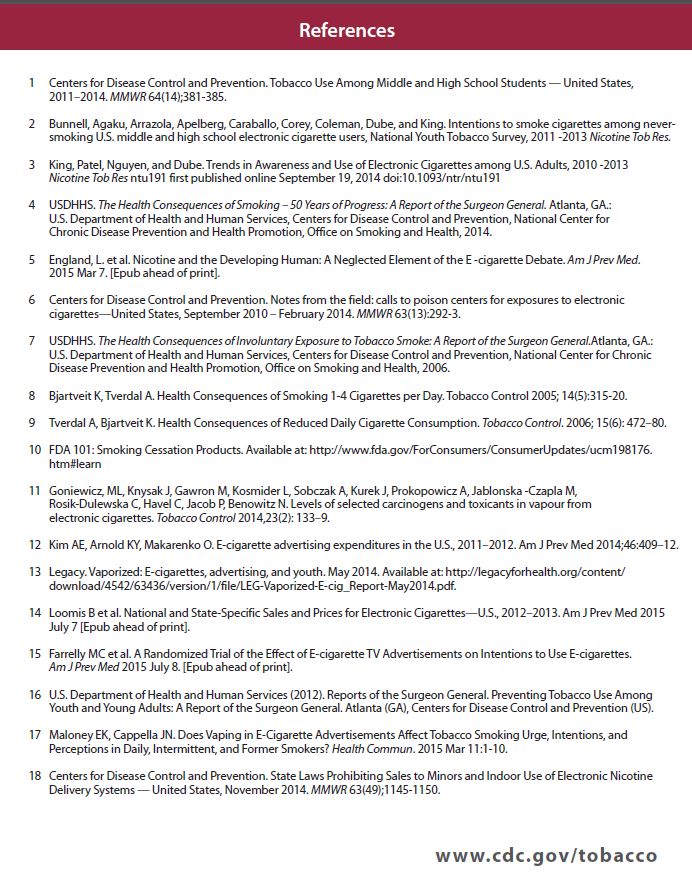Electronic Nicotine Devices and E-Cigarettes
Electronic nicotine delivery systems (ENDS) are battery powered devices that heat a liquid solution, containing nicotine and/or other additives, to produce an aerosol that is inhaled by the user. These products include electronic-cigarettes, electronic-hookahs, vape pens, and electronic-cigars. ENDS are relatively new products, first appearing in the U.S. in 2007.
ENDS typically contain nicotine derived from tobacco and therefore are classified as tobacco products under proposed FDA regulations. The Centers for Disease Control and Prevention has classified ENDS as a tobacco product in traditional surveillance as well. ENDS contain other cancer-causing agents including metals such as lead, chromium, nickel and lithium, according to peer-reviewed studies.
Youth experimentation and use of ENDS has risen sharply within the last decade (King et al, 2014; SGR50), a significant concern due to the potential adverse affects of nicotine on adolescent brain development (Grana et al, 2014) and long term nicotine addiction. Increasing use of ENDS and nicotine addition also undermines recent drops in youth cigarette smoking rates (Arrazola, 2015).
E-cigarettes and other ENDS are not yet regulated by the federal government in terms of manufacturing, product standards, and marketing. In April 2014, the FDA proposed a rule deeming ENDS as tobacco products that would allow the FDA to regulate them. Many tribes, states, and localities have proactively regulated e-cigarettes and other ENDS, including prohibitions on sales to minors, indoor air, and commercial tobacco smoke free policies. However, youth can readily access ENDS in many communities across Indian Country - stronger youth access laws and protections are needed to close this gap.
This is especially concerning because e-cigarette manufacturers use marketing that appeals to kids. Increasing rates of youth e-cigarette use comes as e-cigarette makers marketing their products with the same tactics used long ago to market regular cigarettes to kids, including celebrity endorsements, slick TV, magazine, and internet ads, and sponsorships of race cars and concerts.
In addition, many e-cigarette cartridges come in sweet, colorful flavors such as gummy bear and cotton candy, which helps explain both their appeal to youth and the increase in nicotine poisoning incidents.
The use of nicotine liquids presents yet another human health hazard. In 2014, there were 3,831 calls to poison control centers involving exposures to e-cigarette devices and nicotine liquids, more than double the 1,543 calls in 2013 and more than 13 times the 271 calls in 2011, according to the American Association of Poison Control Centers.
In December, 2014 a one-year-old boy died in New York from swallowing liquid nicotine. Child-resistant packaging for nicotine liquids is not currently required.
E-Cigarette Usage among Native American Youth
The recent introduction of e-cigarettes means that there is limited information on their usage, especially among Native Americans. E-cigarette monitoring and research will be an area of increased importance going forward. It is important for health practitioners to consider including language specific to e-cigarette usage when talking to clients.
The data from the CDC’s 2013 National Youth Tobacco Survey shows that 10.38% of the respondents from grades 6-12 who identified as Native American had ever tried e-cigarettes and 4.37% had used e-cigarettes within the past 30 days.
E-cigarette use (within the past 30 days) among all races of high school students tripled between 2011 and 2013 (from 1.5% to 4.5% who reported using e-cigarettes in the past 30 days).
The 2014 National Youth Tobacco Survey found that for the first time, e-cigarette use exceeded cigarette use among students in all three grades surveyed (8th, 10th and 12th), with more than twice as many 8th and 10th graders reporting using e-cigarettes compared to regular cigarettes (Arrazola et al 2015).
The Data:
- Among 8th graders, 8.7% e-cigarette v. 4% traditional cigarette use in past month.
- Among 10th graders, 16.2% e-cigarette v. 7.2% traditional cigarette use.
- Among 12th graders, 17.1% e-cigarette v. 13.6% traditional cigarette use.
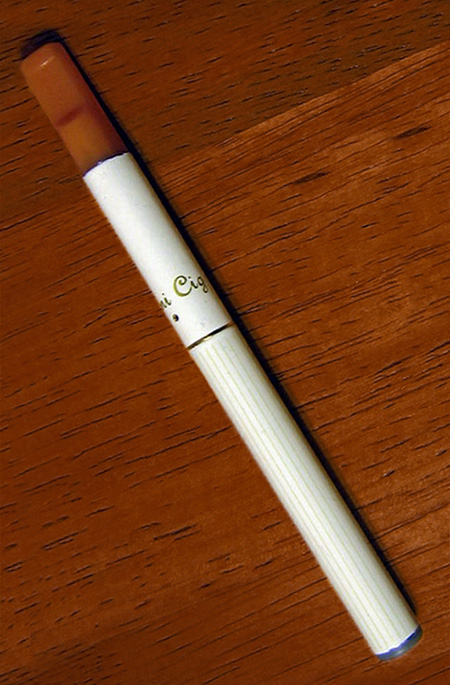
CDC Empower Vape-Free Youth Fact Sheet
 Loading...
Loading...
CDC Empower Vape-Free Youth MATERIAL
CDC Office on Smoking and Health has developed a new campaign "Empower Vape-Free Youth." Material includes videos, fact sheet, print material, and more.
Our Breath is Sacred E-Cigarette Imaging Campaign
Here are e-cigarette/vaping communications resources directed toward Native American and Alaska Native youth. This was developed in partnership with the Hannahville Health Center at the Hannahville Indian Community. Learn more and download here.
ConsumerNotice.org: E-Cigarettes
Electronic cigarettes, or e-cigarettes, hit the United States market in 2007. Since then, millions of people have taken up the tobacco alternative. But there has been little time to research the long-term health effects of the devices, and their widespread use among teens has been called an epidemic that threatens to hook a new generation on nicotine. LEARN MORE
CDC: Outbreak of Lung Injury Associated with the Use of E-Cigarette, or Vaping, Products
Electronic cigarettes, or e-cigarettes, hit the United States market in 2007. Since then, millions of people have taken up the tobacco alternative. But there has been little time to research the long-term health effects of the devices, and their widespread use among teens has been called an epidemic that threatens to hook a new generation on nicotine. LEARN MORE
PDF Vital Signs E-Cigarettes, Advertising, and Youth: A Public Health Priority
Presented by Robin Koval, CEO and president of Truth Initiative
Truth Initiative is the national public health organization dedicated to achieving a culture where all youth and young adults reject tobacco. A leader in the world of advertising and marketing, and a New York Times best-selling author, Koval joined the organization in 2013. She re-launched its award-winning and lifesaving truth youth tobacco prevention campaign and refocused its world-class research and activism programs to speak, seek and spread the truth about tobacco.
A sought-after expert on advertising, media, youth culture and tobacco control, Koval regularly appears on television, contributes commentary to print and online outlets and speaks at conferences and colloquia for business, government and media audiences.
Jeanne Finberg, Deputy Attorney General, Office of the Attorney General of California.
Jeanne Finberg is an experienced litigator in the newly formed Children's Bureau of Justice housed in the Civil Rights Section, Public Rights Division of the California Attorney General's Office, where she works on issues affecting children and teens. Before joining the Children's Bureau, Jeanne served for ten years in the Tobacco Litigation and Enforcement Section where she specialized in the enforcement of the public health aspects of the Master Settlement Agreement, state and federal tobacco and consumer laws. She enforced laws protecting youth litigated cases dealing with advertising issues and against several major tobacco manufacturers. For example, she sued R.J. Reynolds Tobacco Company for using cartoons in its advertising and negotiated an agreement with Santa Fe Natural American Spirit Tobacco requiring them to provide disclaimers on their advertising of their organic tobacco and organic tobacco does NOT mean that it is safer than regular tobacco.
Jeanne has been monitoring the sales and advertising of electronic cigarettes since they were first introduced in the U.S. in 2009. Since then she has been involved in the regulation, oversight, policy work and litigation involving electronic cigarettes and related products.
Tushar Singh, PhD - Epidemic Intelligence Service (EIS) Officer in the Office on Smoking and Health
Dr. Singh is an Epidemic Intelligence Service (EIS) Officer in the Office on Smoking and Health at the Centers for Disease Control and Prevention (CDC), Atlanta. His work includes research on marijuana and tobacco among youth and adults. In addition to this, as part of his work as an EIS Officer, Dr. Singh supports national and international CDC emergency response to investigate and assist with disease outbreaks and epidemics, such as Ebola, E. coli, and meningitis.
Before joining the CDC, Dr. Singh managed a collaborative project between the University of Pittsburgh and SHARE-India to assess the prevalence and risk factors for disability and chronic disease among older Indians. Prior to that, he worked as a medical officer in different hospitals in India.
PDF Electronic Cigarette Use Among Adults: United States, 2014
Report on 2014 e-cigarette usage among adults in the United States by Charlotte A. Schoenborn, M.P.H.; and Renee M. Gindi, Ph.D., published by the US DHHS Centers for Disease Control and Prevention National Center for Health Statistics.
